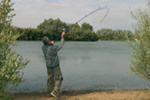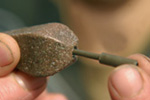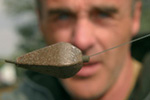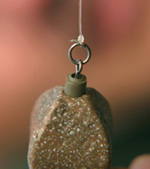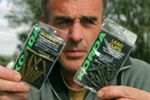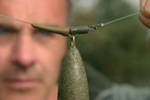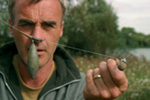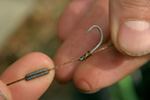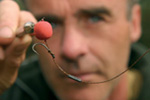Top carp angler Dave Lane reveals how he fishes effectively at ranges of 100 yards plus…
FISHING at long distance, and by that I mean distances in excess of 100 yards, is something that can be achieved by most people with the correct kit and a bit of practice.
Obviously the correct kit is a vital part of the equation. It doesn’t matter how good your technique is, if you are limited by the inadequacy of the tackle you have the distances you can cast will suffer.
My distance set-up is not the only set-up that will add yards to your cast. I use what I do due to my involvement with certain companies and, like all of this technical series, I can only comment on the things that I know about first hand. I will say that I would never limit myself to inferior kit just because of a consultancy fee, so you can rest assured that the gear I recommend is the best I have tried.
Laney’s Distance Kit
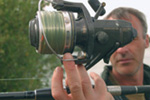 |
| The Big Pit Batirunner has an amazing retrieve rate. |
1. Distance Reels
I prefer Shimano Big Pit Baitrunner reels for distance work. You don’t necessarily need a reel as big as these to cast further but the difference becomes apparent on the retrieve.
The Big Pit Baitrunner has an amazing retrieve rate and takes the effort out of bringing a large lead back from extreme range. Durability is also a major factor and, although there are quite a few cheap, big reels on the market, they need to be able to cope with fish or heavy weed that may need to be pumped back 120 yards or more.
The gearing must be strong enough to cope with everything that you may throw at it over the course of many seasons. If it isn’t, then the money you pay for your cheaper reel will only be a false economy in the long run.
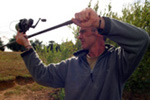 |
| Use a 3-2.5lb test curve rod, but consider the action too. |
2. Which Test Curve?
Just upping the test curve is really not enough to make the required difference with your casting. A test curve, although a good guide to a rod’s strength, will tell you nothing about its action.
As a general rule of thumb, I think you should look for a rod between 3lb and 3.5lb test curve. You need to consider their action, too.
Fast taper rods will be more ‘tippy’. This means that the tip tapers away more quickly – and will bend easily – while the thicker butt section extends higher up the rod to give a solid backbone to cast with.
Unfortunately, a lot of fast taper rods are nothing short of broom poles and are not suited to playing carp. Therefore, when it comes to choosing a rod in the shop, ask yourself if it can cast AND successfully land a fish without tearing out the hook on a shorter line near the net?
Softer action rods, or compound tapers as they are often referred to, will be a lot more forgiving when playing fish but the main body of the blank can lack power when building up for a big chuck.
The ‘recovery time’ of a rod is another vital part of distance casting (recovery time is the amount of time it takes for the rod to straighten after full compression).
A compound taper rod will usually bounce about all over the place when pushed to its limits on the cast, adding friction to the travel of the line through the rings and therefore reducing the overall distance you can cast.
3. Which Rod?
The ideal rod is one that can generate all the required power through the first two-thirds of the blank and still retain enough tip speed for that final ‘flick’ that propels the lead.
The ideal rod needs to have a very fast recovery speed so it can stay poker straight during the flight of the lead but, most importantly, it needs to behave like a proper fishing rod once a fish is hooked.
All these criteria, when taken to their extremes, do not add up to a cheap rod. This is often the reason why true distance rods are expensive. A cheaper rod may look and, sometimes, even feel similar but will it often explode when fully loaded (or just snap in half on a powerful cast).
I have seen both happen many times. I once broke six blanks in a single season while testing out distance rods in fishing conditions. Therefore, a good quality rod is a must, especially from the point of your own safety and that of anglers around you.
I use the new ESP Vertex rods. I’ve found them to be extremely nice rods indeed. I was originally offered a challenge to break one on the cast and, believe me, I really wanted to do it – but try as I might I’ve still not managed it.
The top feature of these rods is the amazing action you get while playing a fish. It’s hard to believe that they can cast as far as they do. As I’ve said, other rods out there will do a similar job but I haven’t used one so I can’t comment. I’m sure any decent tackle dealer will point you in the right direction.
4. Line Choice
Ask yourself this – what is the point of fishing at 140 yards over bars and weed using a 7lb breaking strain line when you have no chance of landing a fish on it?
A lighter line will add distance, there is no doubt about that. This is because friction during the cast is so much less and the line is much lighter. Therefore the lead will travel further.
By tweaking your set-up by degrees and also by improving your casting technique, you should be able to reach distances with a far more sensible main line of 12lb.
Remember when fishing that distance casting is not a competition. It’s only a matter of reaching the fish. Once this is achieved there are no prizes for seeing how far past them you can cast!
5. Shock Leaders
 |
| Use leaders of 25lb minimum for casting 4oz leads. |
For safety reasons you should always use a shock leader when distance casting. The stronger the rod and the faster the taper, the more stress will be put on the line during the cast. Ideally, leaders of at least 35lb should be used for 4oz leads.
I always go for tapered nylon leaders. They cast better, as the gradual decrease in diameter of the tapered leader just slides off the spool with very little resistance.
ESP and Fox both make excellent tapered leaders. They come in a taper from 35lb down to 15lb and join perfectly to the 12lb mono on my spools. The knot I use is one I’ve used for years and came about after a catalogue of disasters with other types.
My mate Curly Bob showed it to me back in my Harefield days and I’ve used it ever since. As well as being very strong it is tapered and both tag ends point in the correct direction, making casting easier.
Tying Laney’s Leader Knot
Unravel your tapered leader and tie a simple, double-overhand knot in the thin end.
Slowly pull the overhand knot together and two loops should appear.
Pass the main line up and down through the loops as shown, leaving 20cm of line past the knot.
Pull the overhand together but do not overtighten it. Just bring it together gently so it’s neat.
Pass the main line eight times around the leader, leaving the first loop loose on the first turn.
Now reverse the main line and come back down FOUR times over the previous whippings.
Wet it and tease it together. When the knot is in position and the coils are orderly, tighten again.
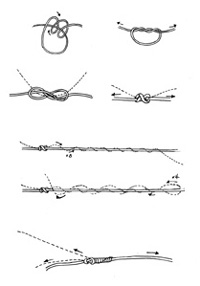 |
| Laney’s Leader Knot. |
6. Distance Rigs
When using tapered leaders I dispense with lead core. In fact, you should NEVER use lead core when distance fishing or with any form of leader. It’s just not safe enough. Even with all the care in the world there is always an outside chance of a crack-off when casting and I’d rather not leave lead core leaders lying about in the lake.
The extra diameter of the shock leaders is usually enough to prevent tangles. It acts in the same way that anti-tangle tubing does, by increasing the main line diameter to a point where it cannot easily wrap with the hook link in flight.
Rigs for long distance should always be kept short, safe and simple! Shorter hook links tangle less and the stiffer the material used the less likely they are to fold back and spin around the main line during extreme casting.
By using a short length of ESP bristle rig filament and a knotless knot to tie on your hook, an effective tangle-free bottom bait rig is so simple to tie and works every time.
For long-range pop-up rigs I either use Fox Mask or Kryston Snake-Bite. The beauty of coated braids is that they are supple enough to allow a pop-up to rise from the bottom but stiff enough to prevent tangles (I am talking about using them with their coating fully intact here).
By breaking the coating to create a hinge rig, I find that you are inviting tangles when it comes to casting. A simple, short length of coated braid with a shot or aerodynamically moulded putty to balance the pop-up, is all that’s required.
Dave’s Distance Rigs
|
|
||||
|
|
||||
|
|
||||
|
|
||||
|
|
||||
|
|
7. Lead Systems
For a totally tangle-free approach, I find a Korda inline lead is the best method. It’s imperative to remove the stiff, inner sleeve and replace it with a Korda ‘Shockleader Sleeve’. This allows the lead to detach easily and pass over the shockleader knot.
The other method I use is to fit a cut-down Korda lead clip onto a size 9 ESP Uni-link swivel, as I find this combination holds firm and releases the lead every time should it become snagged. Distance pear leads or any long-shaped swivel leads are ideal.
The weight of the lead will depend on the gear being used. Overloading a rod with too large a weight will lose distance rather than add it. If you want a rough guide to ideal casting weights, look at using one ounce per pound test curve and then add another ounce to the total.
This equates to 4oz for a 3lb test rod and 4.5oz for a 3.5lb test curve blank. These are maximum weight ratings. Only a good-quality rod will handle them, so it may be a good idea to start at one ounce per pound and only work upwards if needed.
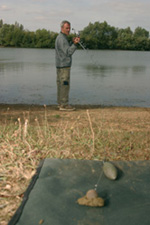 |
| Dave casts off the ground to get that extra yardage. |
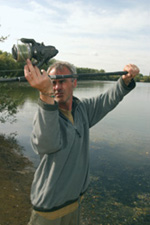 |
| This is the position Dave adopts before casting off the ground |
8. What Cast?
A straightforward, overhead thump is always a good starting point but extra distance can be achieved by varying your casting style slightly. The more compression that you can build up before releasing the lead the better, and by using a slightly longer drop and pushing the lead away from yourself before bending into it you can add extra power to your cast.
The more power you can harness by resistance against the lead on the build-up to release, as the rod compresses, the greater the velocity of the lead as it leaves the rod.
The style I have employed over the years to gain those vital extra yards is to cast from the ground. This slows up the initial movement of the lead and increases torque.
I have a drop from tip to the lead of about six or seven feet and lay the lead out flat behind me using an unhooking mat to ensure I don’t snag the ground.
By mounding a little mud or sand on the mat I can keep the hook point clear and ensure I’m not launching an unhooking mat into space as well. In fact, if sand or mud is in plentiful supply, you don’t even need a mat. Just scatter a tea tray-sized area with sand and dump the rig straight on it.
As you become more proficient you can put the lead further behind your right shoulder and swing into the cast a little. I am not suggesting that anybody goes out and starts pendulum casting on their local lake, as this is a style that requires proper coaching and can be extremely dangerous.
But by laying the lead out behind you and casting off the ground, distances can be increased significantly.
Safety Summary
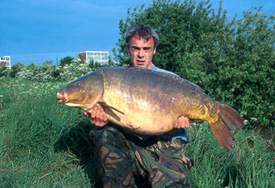 |
| Two Tone… At over 50lb, the biggest fish Dave has caught while fishing more than 100 yards out |
Safety is the main concern when casting. A lead can travel at an amazing velocity. Should it hit somebody, it’s very capable of killing them. Always check the area around you before casting and try not to aim directly at anglers on the far bank in case of a crack-off.
Use an adequate leader with a safe rig and there is no reason why you shouldn’t cast as far as needed with total accuracy and safety.
A local playing field or a large, deserted gravel pit, where you can upset no other anglers, are far better places to practice your casting than busy lakes. Once you have a technique that you are happy with, and tackle that is man enough for the job, you may well be amazed at the distances you can achieve.


